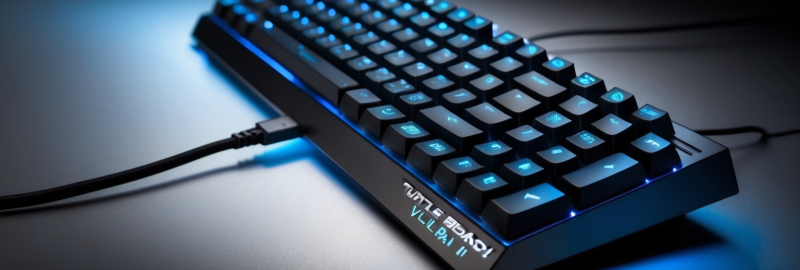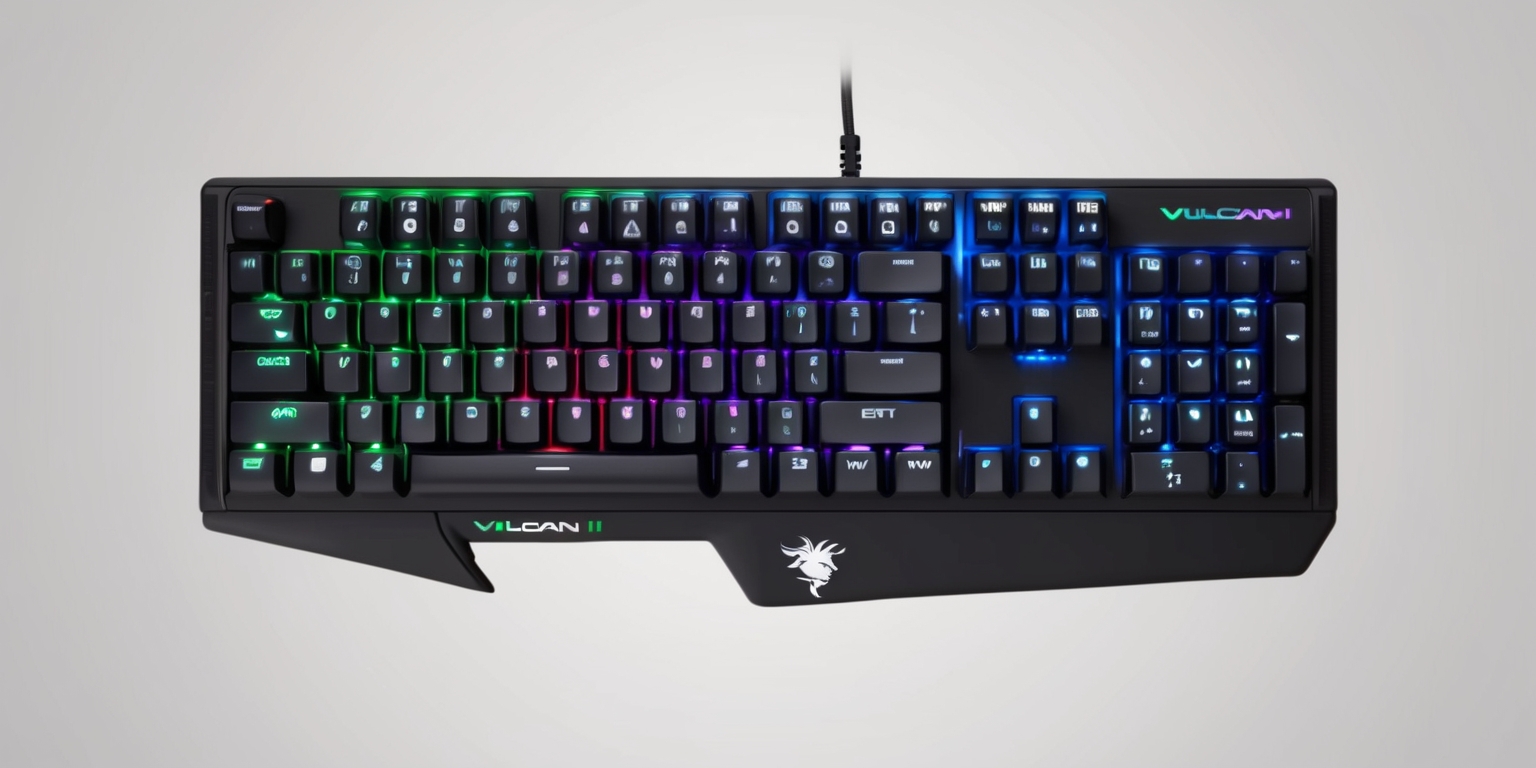
The Turtle Beach Vulcan II TKL stands out by offering a distinct twist in the world of gaming keyboards. Its design and performance evoke an experience that challenges preconceptions while delivering a fluid and responsive feel during use. This wiring-driven mechanical keyboard diverges from the growing trend of magnetic and Hall effect switches to focus on a more traditional, yet refined, mechanical architecture. From its smooth switch actuation to the integrated controls and versatile layout, every detail has been reconsidered with both gamers and everyday users in mind. The approach taken with this device invites a closer look at its aesthetic design, internal functionality, and the overall tactile experience it brings to the table.
Design and Build Fundamentals
The Vulcan II TKL presents a nod to industrial design with its exposed switches and a sleek all-black chassis that recalls previous generations of the brand while establishing its own identity. The keyboard’s exterior is crafted with a plastic body paired with an aluminum top plate that, despite its lighter sound compared to more premium counterparts, provides a solid, reassuring feel. Underneath this minimalist exterior, sound-absorbing dampening elements are thoughtfully placed to reduce unwanted acoustic resonance, creating a quieter operational environment. The tactile aesthetic is enhanced by subtle LEDs that shine through the slim keycaps, offering an understated yet engaging visual appeal. The brand’s modest use of its logo also reinforces a clean, reserved look that harmonizes with modern ergonomic preferences.
Smooth Switch Mechanism Experience
Central to the Vulcan II TKL's design is… You can adjust the continuation as needed to fit the rest of your sentence is the implementation of Turtle Beach’s own Titan HS linear switches, pre-lubed for enhanced performance. Designed to provide an exceptionally smooth actuation, each press is accompanied by a soft clack sound that balances auditory feedback with a cushioned landing. The shorter actuation distance of 1.8mm along with a moderate force requirement ensures fast response times. Users quickly notice the difference in how each key registers; the firmer landing on larger keys even helps maintain a tactile diversity across the keyboard. With the added benefit of hot-swap compatibility for potential switch replacements, the design gives enthusiasts room for customization. However, the installed switches are securely mounted, making removal a deliberate process that may demand a bit more patience during any modification attempts.
Enhanced Keycap and Lighting Display
The keyboard’s keycaps present both an aesthetic and functional narrative. While the TKL version opts for more cost-effective ABS legends, these keys initially offer a subtle shine and consistency that accents the overall design. The original T-shaped layout supports its visual flair, with underglow effects emphasizing a crisp and modern feel. Yet, the absence of textured surfaces on the keycaps may eventually lead to issues with moisture or grip during extended sessions. This design decision invites users to consider third-party keycap replacements if they desire both improved durability and a refreshed visual impact. The customizable option does come with its own caveats, though, as after-market kits designed for low-profile keys might not match perfectly, urging users to consider compatibility when upgrading their keyboard’s look.
Software Flexibility and Customization

Ease of customization is a priority with the Vulcan II TKL, largely due to Turtle Beach’s Swarm II software. This lightweight tool offers a streamlined interface for keybindings, macro creations, and RGB lighting adjustments. The software’s visual layout resembles the physical design of the keyboard, ensuring intuitive navigation while remapping individual keys. For those who enjoy personalizing their peripheral devices, the program provides an accessible method to adjust SOCD configurations and various control settings that adapt to different usage scenarios. Although the interface is straightforward, occasional quirks, such as unexpected alternate layouts, may require a brief period of adjustment. Nonetheless, the software reinforces the keyboard’s commitment to versatility, allowing both casual users and competitive gamers to tailor their experience according to individual preferences tastes.
Integrated Media Controls
A notable advantage of the Vulcan II TKL is its thoughtfully integrated media control suite. With a dedicated volume dial that features a raised design and noticeably different physical feedback, the control set stands out from the conventional flat roller found in some competitors. This design facilitates easier adjustments during fast-paced gaming or multitasking scenarios on the desktop. The function row also neatly incorporates media playback functions, making it a practical tool for users who wish to manage audio without diverting too much attention from their primary tasks. The separate navigation cluster, combined with clear labeling and accessible positioning, underscores the keyboard’s commitment to balancing gaming functions with everyday productivity. This clever arrangement allows quick toggling between intense gaming sessions and routine computer use, highlighting the versatility embedded within its TKL (tenkeyless) form factor.
Connectivity and Performance Considerations
The keyboard’s wired connection via a USB-C cable ensures a robust and consistent data exchange, supporting a 1,000Hz polling rate that suits both enthusiasts and competitive players. While some might debate the value proposition in the context of wireless contenders at similar price points, the consistent, low-latency performance provided here remains a strong selling point. The precise link between the computer and the device eliminates typical connectivity issues, ensuring that each keystroke is registered in real-time during both gaming and productivity tasks. Despite the modest premium often associated with wired models, the reliability and speed that come with this cable connection provide users a seamless integration with high-performance systems. The combination of hardware design with dependable connectivity resonates with gamers who demand precision and low lag in every keystroke.
Keyboard Tactile Experience and Typing Dynamics
Using the Vulcan II TKL for prolonged typing sessions reveals a unique tactile experience that sets this keyboard apart from its contemporaries. The sound-dampening measures coupled with the exceptionally smooth linear switches result in a quiet yet responsive interface. Users may notice that while the primary alpha keys offer a crisp tactile feedback, larger keys like the space bar, enter key, and backspace provide a more subdued interaction with a cushioned feel that some might initially find unfamiliar. This discrepancy in feedback can affect typing accuracy during rapid input, though the benefit of a shorter actuation distance often leads to increased speed upon adjustment. The design, intentionally calibrated to support both gaming and office scenarios, demands a period of adaptation, eventually rewarding users with a comfortable, fast-paced typing dynamic well-suited for extended use.
Performance in Competitive Gaming Scenarios
The Vulcan II TKL delivers a performance profile that comfortably meets the needs of competitive gaming, offering responsiveness that proves valuable in fast-paced environments. With its rapid polling rate supporting a 1,000Hz refresh, the keyboard ensures that commands are transmitted quickly to the system for near-instantaneous reaction. This balance of speed and precision means that although it may not be at the absolute cutting edge reserved for tournament contenders, it remains highly competitive for most online gaming arenas. The compact TKL design minimizes desk clutter while maintaining function keys and dedicated media controls, striking a balance between ergonomics and performance. Gamers appreciate the refined tactile feedback from the smooth, pre-lubed switches; however, the distinctive feel of certain larger keys might require a brief adjustment period during high-pressure gaming sessions.
Functionality in Everyday Tasks and Multitasking
Beyond the realms of gaming, the Vulcan II TKL is surprisingly adept at handling everyday tasks Whether it's set up in a professional workspace or a private residence, the well…-spaced layout, including an easily accessible function row and separate navigation cluster, proves beneficial when switching between detailed work and casual browsing. For those who frequently engage with multimedia content, the dedicated volume control and media functions enhance the overall workflow. This versatile peripheral adapts quickly to different user needs, ensuring a reliable experience whether writing long documents, managing spreadsheets, or performing daily communication tasks. The robust build and integrated sound dampening Instead of "not only reduce noise but also contribute to," you could say "not simply lower noise levels but also help enhance." maintaining concentration in quieter settings. This all-encompassing functionality demonstrates that the keyboard is engineered to cater to both high-intensity gaming sessions and routine, productivity-focused computer use.
Insights from Extended Usage and Practical Considerations
After several weeks of rigorous use,, the Vulcan II TKL reveals nuances that highlight both its innovative design and modest compromises. Regular usage under diverse conditions—from rigorous gaming sessions to long typing sprints—demonstrates a level of adaptability that many users will appreciate. The integrated software options allow for swift customization, making it possible to tailor the device to match individual preferences and workflows. Despite the firm installation of switches that may make spontaneous modifications challenging, the overall durability and performance are consistent throughout extended daily use. The keyboard’s physical features, such as the tactile disparity between different key sizes, begin to feel like familiar idiosyncrasies that users eventually grow fond of. This lengthy exploration of the device underscores a balanced blend of innovation and practicality that adapts well to varying user demands.